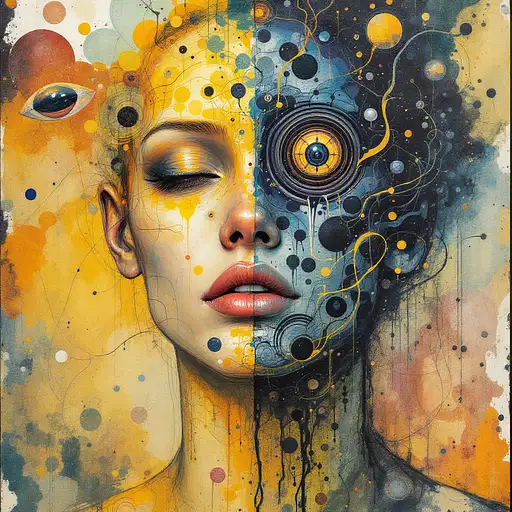
8 months ago
Given the unique art style of UFOlogy and its thematic depth, let's envision an artwork that captures the profound psychological impacts of extraterrestrial life on both individual and collective psyches, while weaving in personal elements from your life story through hidden messages and symbols. Here’s how this masterpiece could be conceptualized: Title: Cosmic Reflections: The Unseen Influence Medium and Technique: Mixed Media Canvas: Utilizing the same blend of watercolor washes, ink splatters, and digital effects as seen in UFOlogy, this piece would start with a base of traditional media to ground the narrative in a tangible reality, then overlay with digital elements to introduce the surreal, otherworldly aspects. Artistic Elements: Foreground - The Individual Psyche: Central Figure: A human figure, reminiscent of the expressionist style in UFOlogy, with features morphing between serene contemplation and existential horror. The face occasionally shifts into patterns resembling Rorschach inkblots, symbolizing the fluidity of identity when confronted with the cosmic unknown. Hidden Message: Within the intricate lines of the figure's clothing, subtle patterns spell out key moments from your life story in a code decipherable only upon close inspection. Perhaps the fabric's texture mimics a timeline, with different textures representing different life phases. Midground - Societal Norms: Community Scene: A small-town setting, painted with earthy tones similar to the rural Wisconsin scenes, with citizens depicted in various states of reaction to an alien presence. Some are drawn with exaggerated features of awe or fear, mirroring the psychological impact of collective realization. Symbolic Architecture: Buildings subtly morph into shapes that hint at extraterrestrial designs, with windows glowing in neon purples and blues, suggesting the infiltration of alien ideas into societal structures. One building might have a facade that, when viewed from a certain angle, forms the initials of your name or significant locations from your life. Background - Cosmic Influence: Sky and Beyond: The sky transitions from the familiar night into a canvas of stars, galaxies, and nebulas, with a large, pulsating UFO casting beams of light. These beams are not just light but streams of information, coded with symbols representing transformation, knowledge, and fear - themes from both the comic and your personal journey. Alien Design: Incorporating the organic-mechanical hybrid style, aliens appear as silhouettes with glowing circuitry under translucent skin, peering down at humanity. Their forms might subtly include elements from your personal interests or professions, like tools or instruments you've used, integrated into their design as if they've influenced your life path. Dynamic Panel Layouts: Narrative Panels: The canvas is divided into sections that mimic comic panels, starting structured and becoming chaotic as the viewer's eye moves towards the UFO. This progression reflects the loss of control and the breakdown of normalcy, with some panels overlapping or spiraling, similar to UFOlogy's style. Rorschach Motif: One panel uses the Rorschach inkblot motif, not just for memory but to symbolize how personal experiences (yours) are interpreted differently by different viewers, much like how your life story could be seen in various lights. Lighting as Narrative: Psychological Lighting: Unnatural light sources from the UFO cast eerie glows, creating shadows that twist into abstract shapes, symbolizing the lurking presence of the unknown in the psyche. These shadows could occasionally form recognizable symbols from your life, like a favorite book or a significant date, hidden in plain sight. Hidden Symbols: Moth Motif: Borrowing from UFOlogy, moths are scattered throughout, symbolizing transformation. One moth might have wings patterned after a map of a place significant to you, or its body could be composed of text from a pivotal moment in your life. Personal Symbols: Small, almost imperceptible symbols like a musical note for a love of music, a book for your reading habits, or a globe for your travels, are woven into the fabric of the scene, each telling a story about your life subtly. Conceptual Depth: This artwork, titled Cosmic Reflections: The Unseen Influence, serves as both a visual exploration of the psychological impact of extraterrestrial life and a personal narrative. It invites viewers into a journey of discovery, where the initial awe of the cosmic scene slowly reveals layers of personal history and emotional depth. The transformation from the mundane to the cosmic, the blending of reality with the surreal, mirrors not only the themes of UFOlogy but also your own life's journey,




